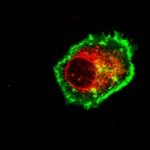Link to Pubmed [PMID] – 23563139
Nat. Struct. Mol. Biol. 2013 May;20(5):634-40
Glutamate transporters catalyze concentrative uptake of the neurotransmitter into glial cells and neurons. Their transport cycle involves binding and release of the substrate on the extra- and intracellular sides of the plasma membranes and translocation of the substrate-binding site across the lipid bilayers. The energy of the ionic gradients, mainly sodium, fuels the cycle. Here, we used a cross-linking approach to trap a glutamate transporter homolog from Pyrococcus horikoshii in key conformational states with the substrate-binding site facing either the extracellular or the intracellular side of the membrane to study binding thermodynamics. We show that the chemical potential of sodium ions in solution is exclusively coupled to substrate binding and release, not to substrate translocation. Despite the transporter’s structural symmetry, the binding mechanisms are distinct on the opposite sides of the membrane and more complex than the current models suggest.

